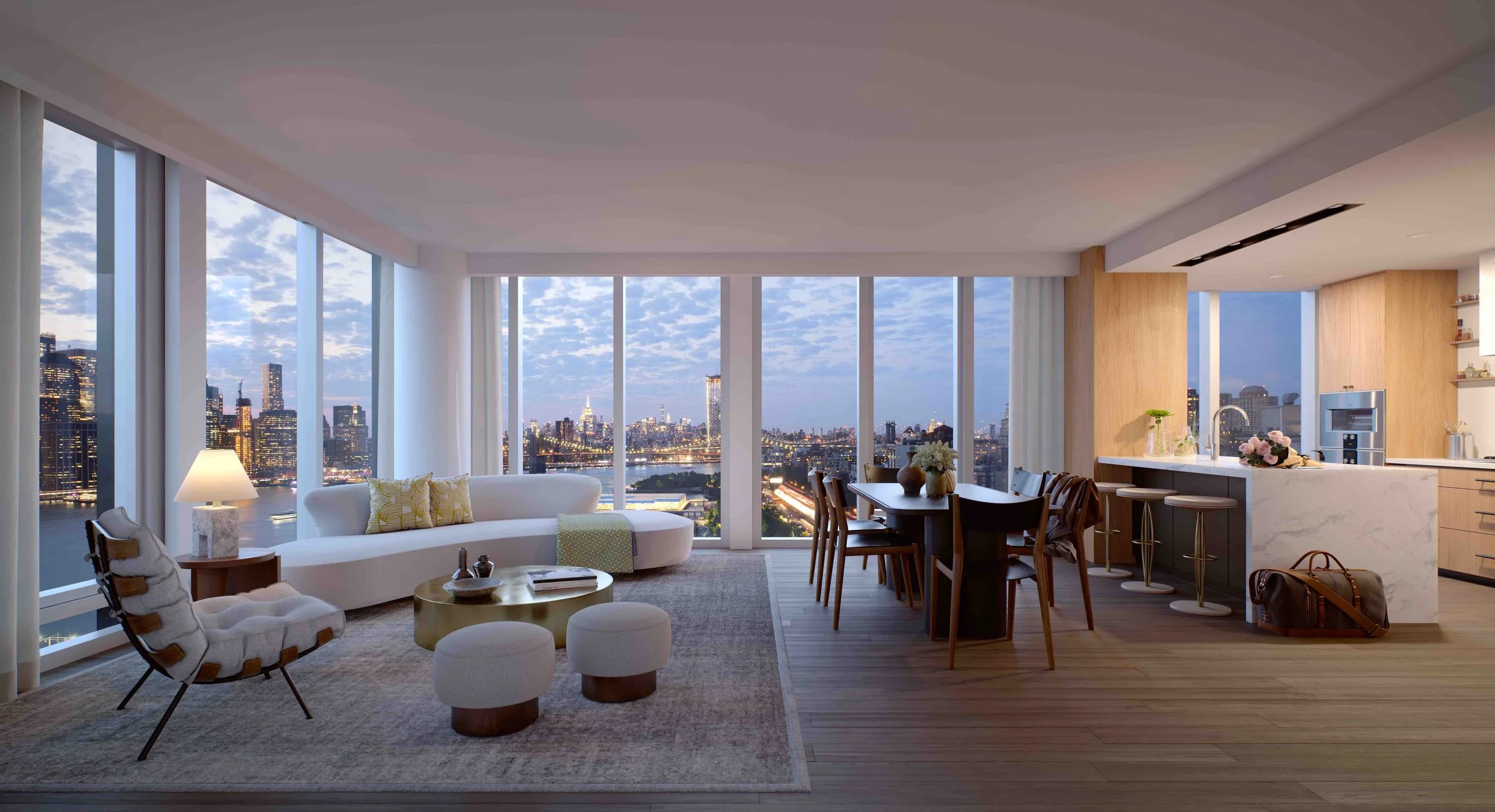The Evolution of Brooklyn Waterfront's as told by Robert Levine
Courtesy of Quay Tower
Can you explain the state of the Brooklyn waterfront where Brooklyn Bridge Park now exists 20 years ago?
Twenty years ago Brooklyn Bridge Park was a working waterfront with no public access. The piers were fenced off and Pier 6 was still active and used to store bags from coffee beans. The waterfront was very industrial and derelict. For more than twenty years before any development began, the community wanted to build a park and create waterfront access.
When did you first become intrigued by the potential of the sites available for development?
A year before we toured the property, I was driving along the BQE with Vincent Cangelosi, RAL’s Managing Director of Design & Development. We both were struck by the opportunity for a great conversion. In 2001/2002, 360 Furman Street came on the market for sale. This development was ultimately the catalyst for the creation of Brooklyn Bridge Park.
Credit: Evan Joseph
There were many parties interested in the Jehovah Witness buildings. We were selected and acquired the site. We had been speaking with the city and state about the potential to link up 360 Furman with the Park. Ultimately we proposed a plan where we contributed 360 Furman to the Park to get the building included within the Park and in return got a zoning override and were permitted to convert the building to residential under their guidelines and directions. Entitlements and easements had to be worked through and this project finally opened access to the waterfront.
Can you speak towards the BBP model of funding annual maintenance with private development sites? This was a new model and at the time there was opposition to leasing off park land? How does this system relate to the success of the area today?
As the first development site in Brooklyn Bridge Park, we were heavily involved in structuring and implementing this funding program. The Park wanted to collect payments in lieu of taxes (or PILOT) directly from each project so they could be used to make the Park self-sustaining, rather than having traditional real estate taxes paid to the City. To accomplish this, ownership of the land could not be transferred to a developer, so the Park proposed a ground lease mechanism. Unfortunately, residential condominiums cannot be developed on a ground lease in New York without express authorization in New York’s Condominium Act. We led the charge to get the State legislature to amend the Condominium Act to allow qualified leasehold condominiums to be developed in Brooklyn Bridge Park. At the time, only three other places in New York were permitted to have residential leasehold condominiums: Battery Park City, Queens West and Roosevelt Island. Once Brooklyn Bridge Park was added to that list, PILOT payments made by each condominium project can go directly to the Park, to be used for enhancing and improving the neighborhood, and those payment are actually deductible by condominium owners in the same manner as real estate taxes. In our Brooklyn Bridge Park ground leases, PILOT payments track the amounts that would otherwise have been paid as real estate taxes based on the City tax assessor’s valuations, for additional transparency. This leasehold condominium / PILOT program was used for several other development sites within the Park after it was implemented for 360 Furman.
How do land leases with the City work for those who are not familiar with the process?
In the case of land-lease buildings, the land isn't owned by the building (or more precisely, by its owners or shareholders) but leased from a third party. Most land leases in New York City run for 99 years with the option of a 20-year extension. In the case of One Brooklyn Bridge Park at the end of the lease term the land reverts back to ownership.
Please detail the inception of One Brooklyn Bridge Park aka 360 Furman and unique zoning, engineering and design hurdles to building this project.
Credit: Evan Joseph
One Brooklyn Bridge Park was originally built as a warehouse in 1928 and is grand in scope, and scale. The conversion and required deep floor plates and heavy concrete construction. We cut off a 12-ft parapet which was an extensive undertaking. It was the largest commercial to residential building in Brooklyn at the time and one side of the project is tucked against the Brooklyn Queens Expressway.
How did you determine the massing of Quay Tower? Were there limitations you needed to work with to get the design approved?
The massing of Quay Tower was actually pre-determined by Michael Van Valkenburgh Associates, the design team for Brooklyn Bridge Park, so our design would fall into pre-existing parameters. That was all outlined in the extensive general project plan for the Park.
We were actually unaware that the Park would propose two buildings to the south of us at 360 Furman and found out at a meeting. Once this happened, we couldn’t change the direction. Luckily we were the successful respondents to the RFP for those buildings and we always showed the plans in our marketing materials for 360 Furman for transparency and took them into consideration when pricing the units.
Quay Tower continues to outperform the Brooklyn market. What are some notable recent deals and what remains available to purchase?
Quay Tower is home to a record-breaking $20.3 million Penthouse and continues to break price records in the borough. Two notable deals in 2023 were spectacular penthouses asking $9.85 million and $10 million. Success at Quay Tower lies in the vision of creating large residences intended for families to enjoy the Park and waterfront lifestyle with a robust amenity program, ample parking and access to one of New York’s cherished historic neighborhoods.
Can you speak towards the development of the Landing at Brooklyn Bridge Park and the inclusion of affordable housing at this site?
Having residential development on the Park for the whole community was necessary. When the RFP came out for Pier 6 and the two development sires, the success of the Park was already established. Brooklyn Bridge Park Development Corporation suggested in the RFP that you should consider an affordable component. We created Quay Tower as a for-sale high end product and The Landing as a rental. Traditionally to do a rental and get an incentive, the mix is 80/20 market/affordable. The Landing was a reverse 80 percent affordable and 20 percent market. We subsidized with the dollars being generated at Quay Tower. The Landing was groundbreaking in this respect and wasn’t built as affordable in terms of quality. The units are high-end with condo-level finishes. It’s the only way we build.
Brooklyn Bridge Park residential developments are in a flood plain, can you detail how you mitigated flood risk and incorporated resiliency measures into these projects?
The two buildings address resiliency differently. The Landing does not have a basement and the floodplain is between the buildings so they are actually in two different flood zones. We elevated electric and fire equipment to safeguard against flooding.
Credit: Evan Joseph
We raised the ground floor above the flood plain at Quay and the basement is waterproof. We had to dig through the water and then tighten and seal. Even during tidal events there are no issues. Resiliency was incorporated into both projects and nothing critical is at the base of the structures.
I understand that One 15 Brooklyn Marina has a custom state-of-the-art wave attenuation system resulting in calm waters and can dock superyachts up to 300 feet. What kind of activities can locals enjoy at the marina?
The wave attenuation is actually the second one installed. The Park learned from its experience that the waves created in the river are substantial. The system in there now works extremely well. The marina is accessible to everyone. There are boats of all sizes available for use, sailing, etc. Nearby you can kayak for free. The range of activities is incredible.
Please explain the retail mix at Quay Tower and how Ral Companies approaches finding the right businesses for both the community and the residents at the building.
We approached the retail for convenience of our residents and the community. Our family-focused retailers like sports, activities and day care have been the most popular including a full service supermarket.
Piers 7 through 12 just south of Brooklyn Bridge Park remain in Port Authority despite dwindling maritime operations, what are your thoughts on the future of this working waterfront?
We believe an active waterfront is an integral part of the character and fiber of NYC. It’s very cool to see how much goes on at these Piers. We know there is chatter about development but personally feel development here is decades away. It’s the only true port left!
Robert A. Levine is the founder and CEO of RAL. A renowned developer and graduate Planner/Architect, Mr. Levine has been responsible for the development of more than 100 luxury residential, hotel, and mixed-use projects throughout the country totaling in the hundreds of millions of dollars in project valuations.




